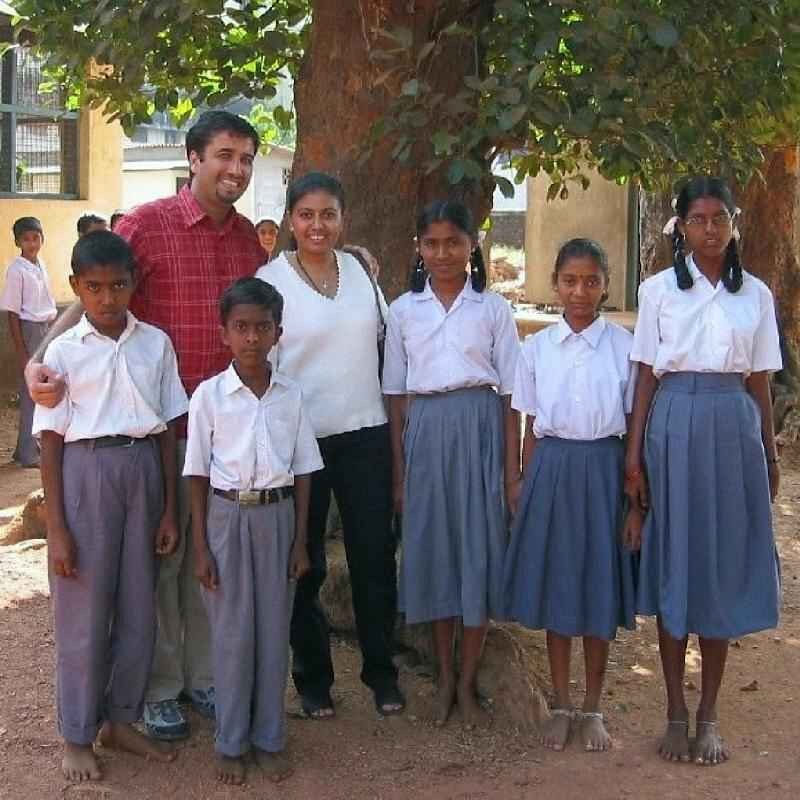
Indian Schools: Individual Schools

Figure 1.--This photograph was taken in Pune, the second largest city in the western Indian state of Maharashtra. The school takes its name from Kota Shivaram Karanth (1902-1997). He was an Indian writer, one of the main writers in the Kannada language. The school has a mandatory uniform. The boys wear gray long trousers and white shirt; the girls wear gray skirt and white shirt. In this photo we can see that going to school barefoot is not a poverty matter, but rather a children choice. We can see that two girls wear ankle-bracelets, but not footwear.
|
|
We have very little information on individual Indian schools. We are collecting information to better understand schoolwear and educational trends. We have collected information on a few schools at this time, both public and private schools. We incourage readers to send us information about their school so we can expand our coverage.
A reader has sent us an image from an unidentified primary school. Our reader tells us that it is a typical primary school from western India.
We see two Indian brothers on the way to school. They attend Chettinad Vidyashram, a private school in Chennai (Tamil Nadu). The school enrolls children from kindergarten to high school. The pupils are taught in English, and two other languages: Hindi, Tamil, Sanskrit, or French are mandatory. The school uniforms are different for the different levels and also for the different days. The boys attending primary school are required to wear:
On Monday: white shirt, white short pants, maroon tie.
On Friday (cultural activities): cream colored pyjama and kurta.
The other days: blue and white checked shirt, blue short pants, maroon tie.
These boys live in a village near Kovalam (Kerala). They are wearing the school uniform. Each school adopts its own uniform. The uniform is white short-sleeves shirts with red ties and kaki shorts. The footwear is optional and, as very common in southern India, they prefer to go barefoot.
La Martiniere is today one of India's most prestigious private schools. It has a fascinating history full of irony. It was founded by a Frenchman, but has operated as a traditional English public school. The students fought the Indian rebels in the Great Mutiny (1857), but the students are now Indians. The school was the model for St. Xavier--the school depicted in Rudyard Kipling's classic novel Kim. Today the school uniform is a blue blazer with the school crest on it, grey long trousers, black shoes, white shirt and tie.
Dr. Shivaram Karanth School
This photograph was taken in Pune, the second largest city in the western Indian state of Maharashtra (figure 1). The school takes its name from Kota Shivaram Karanth (1902-1997). He was an Indian writer, one of the main writers in the Kannada language. The school has a mandatory uniform. The boys wear gray long trousers and white shirt; the girls wear gray skirt and white shirt. In this photo we can see that going to school barefoot is not a poverty matter, but rather a children choice. We can see that two girls wear ankle-bracelets, but not footwear.
Christians are a relatively small denominstion in India. They have, however, played a major role in the development of the Indian education system. The Union Christian College was founded in Aluva (Kerala, southern India) in 1921 as a Centre of Christian Higher Education and as a venture in inter-denominational cooperation among the Malankara Orthodox Syrian Church, the Malankara Jacobite Syrian Church, the Church of South India and the Mar Thoma Syrian Church. This is a class photo taken in 1941. Usually the Indian school uniforms are western-style. Here we can see that the boys are wearing lungi.
Widia Poorna Pragna School is an Kanada/English-language school in Bangalore (Karnataka, India). The primary language is
Kanada and English is used as a second language. The school is coeducation, although some of the classess appear to be single gender. It is a state boarding school established in 1968. We are unsure why the state is running a boarding school or how the pupils are selected. The average number of students per class is 25,relatively low by public school standards. The school has a library bnd computer center. Extra curricular activities include sports, dance, and music. The boys wear a uniform of yellow shirts, striped tie, and khaki slacks. There are blue jumpers for cool days. We are not sure about the girls' uniforms.
HBC-SU

Related Chronolgy Pages in the Boys' Historical Web Site
[Late 19th century]
[The 1930s]
[The 1940s]
[The 1930s]
[The 1940s]
[The 1950s]
[The 1960s]
[The 1970s]
[The 1980s]
Related Style Pages in the Boys' Historical Web Site
[Long pants suits]
[Knicker suits]
[Short pants suits]
[Socks]
[Eton suits]
[Jacket and trousers]
[Blazer]
[School sandals]
Navigate the Boys' Historical Clothing Web Page
[Return to the Main Indian school page]
[Introduction]
[Activities]
[Biographies]
[Chronology]
[Cloth and textiles]
[Clothing styles]
[Countries]
[Topics]
[Bibliographies]
[Contributions]
[FAQs]
[Glossaries]
[Images]
[Links]
[Registration]
[Tools]
[Boys' Clothing Home]
Created: 9:46 PM 8/7/2009
Last updated: 5:07 AM 10/22/2010




